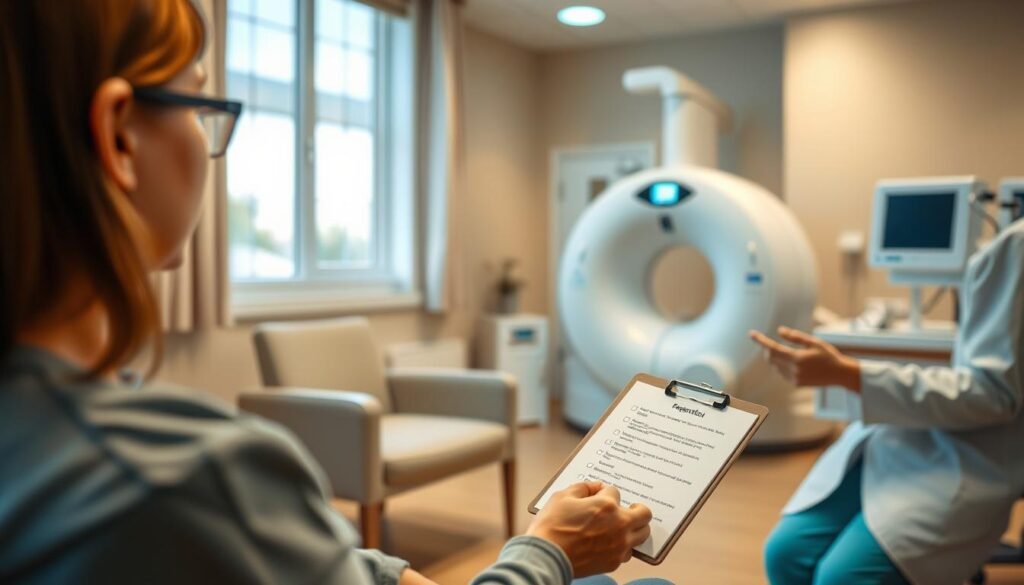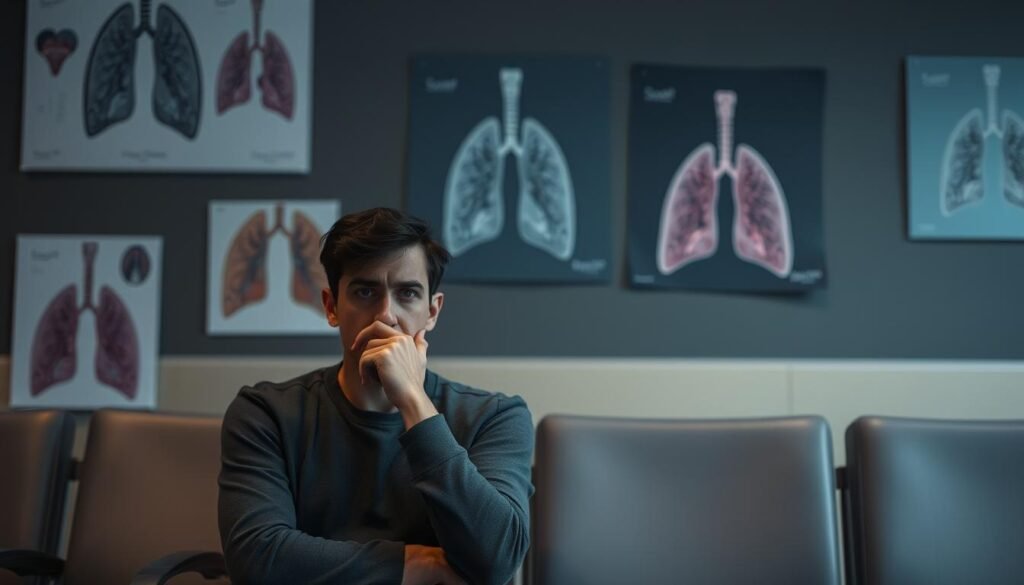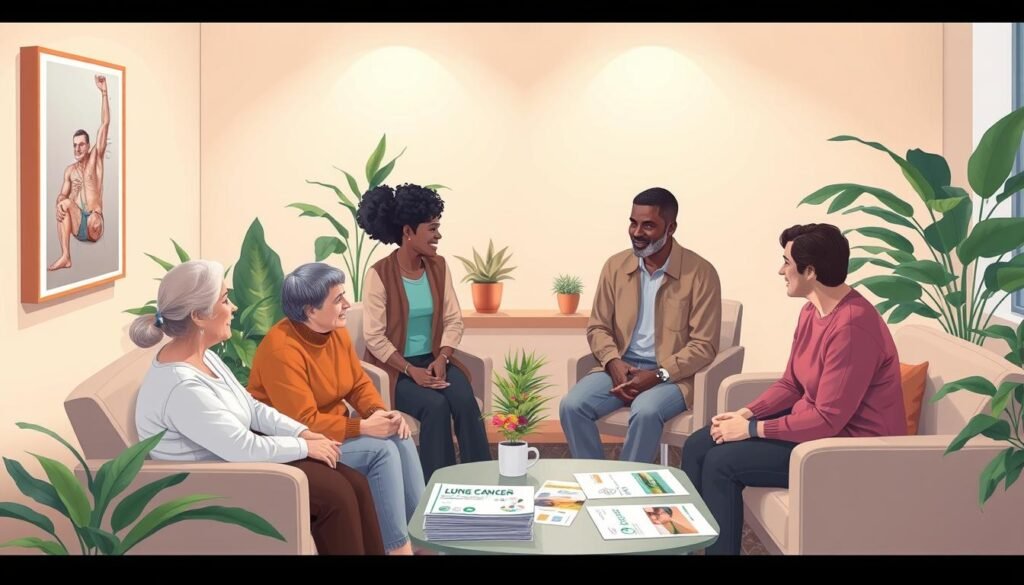Lung cancer is the top killer among cancers in the United States. It takes more lives yearly than colon, breast, and prostate cancers combined. Around 150,000 Americans die from it each year. Getting ready for lung cancer screening is crucial.
Low-dose computed tomography (CT) scans can catch the disease early. This early detection can reduce lung cancer deaths by 20%. Yet, only 20% of those who could benefit from this scan actually get it.
Getting ready for a lung cancer screening means knowing what to expect. It means understanding the benefits and risks. It also involves steps you should take before the procedure. The scan is fast and easy. But you should first check if you’re eligible with a health expert. This article gives vital information and tips on lung cancer screening for anyone thinking about this key health step.
Key Takeaways
- Lung cancer screening is suggested for people 50-80 years old who have smoked a lot.
- Low-dose CT scans use much less radiation than normal scans.
- Finding the cancer early greatly raises chances of surviving; stage IA lung cancer has over a 75% chance of survival after five years.
- Easy steps for preparation can make the screening smoother.
- Talking with healthcare experts helps make wise decisions regarding lung cancer screening.
Understanding Lung Cancer Screening
Lung cancer screening is crucial. It finds lung cancer in those at risk but without symptoms. The main screening method is a low-dose CT scan. This scan is effective in improving lung cancer detection.
This type of scan spots abnormal lung areas early. Early discovery leads to better treatment success.
The US Preventive Services Task Force advises yearly screenings. This is for people 50 to 80 years old who smoked a lot. A “pack-year” means smoking one pack a day for a year. It’s particularly important for current or recent smokers.
Screenings can find cancer early. But, there are risks like false positives and overdiagnosis. Low-dose CT scans use some radiation. It’s more than an x-ray but less than a regular CT scan. Discussing these risks with a doctor is vital to make the right choice.
Screening is advised for adults at high risk but in good health. It helps detect cancer early without severe health issues being a barrier. The Task Force suggests stopping the screening at 81 years. Or, if a person stops smoking for 15 years. Or, if they develop certain health problems.
Good news, though. Lung cancer screening is usually covered by Medicare and many insurance plans. Low-dose CT scans can save lives by catching lung cancer early. Knowing about these screenings helps people make smart health choices.
| Age Group | Smoking History | Screening Recommendation |
|---|---|---|
| 50-80 years | 20 pack-years or more | Yearly low-dose CT scan |
| 81 years and older | Not applicable | Discontinue if health issues arise |
| Quitting duration | Quit for 15 years or more | Discontinue screening |
Who Should Consider Lung Cancer Screening?
Finding out who needs lung cancer screening is key to catch it early. People at high risk based on certain factors should get screened. This group mainly includes older adults and those who have smoked a lot.
High-risk Criteria for Screening
The main focus is on people 50 or older with a 20 pack-year smoking history. This group includes:
- Current smokers
- Former smokers who quit within the last 15 years
- Individuals with a prior lung cancer diagnosis
- People with chronic obstructive pulmonary disease (COPD) or a family history of lung cancer
- Those exposed to asbestos
Talking with a doctor can make it clear if someone should be screened. They’ll use these criteria to decide.
Age and Smoking History
The chances of getting lung cancer go up with age and smoking. People over 50, especially if they smoked a lot, should think about screening. Heavy smokers are far more likely to get lung cancer than non-smokers. Discussing these points can raise awareness and lead to early treatment.
| Criteria | Details |
|---|---|
| Age | 50 years and older |
| Smoking History | 20 pack-years or more |
| Current Smokers | Individuals who smoke now |
| Former Smokers | Quit within the last 15 years |
| Health Conditions | COPD, history of lung cancer, asbestos exposure |
Benefits of Lung Cancer Screening
Lung cancer screening has major advantages, mainly by spotting the disease early and treating it quickly. Lung cancer is the top reason for cancer deaths in the U.S., so fast action is key. Regular screenings can find lung cancer before symptoms show. This increases the chance of beating the disease.
Early Detection and Treatment
Spotting lung cancer early is a big plus of screening. It makes beating the disease more likely. Nearly half of lung cancers are found early because of screening. This makes them easier to treat. People at high risk get yearly scans to find it early. The goal is to treat the disease fast. This could lower the number of people who die from lung cancer. To learn more about screenings, check out this link.
Reducing Mortality Rates
Screening has been shown to cut lung cancer death rates. Research shows that screening lowers the death risk by about 20 percent. For those at high risk, this screening is life-saving. Lung cancer causes 28% of all cancer deaths in the U.S. Yet, early detection raises a five-year survival rate to 52%. By screening early, we can save more lives.
Risks Involved in Lung Cancer Screening
Lung cancer screening has benefits, like catching cancer early. But, there are risks to consider, too. You might be exposed to radiation, get a false positive, or find something that isn’t harmful. Knowing these can help you make better choices for your health.
Radiation Exposure
Low-dose CT scans expose you to some radiation. It’s about the same amount you’d get from nature in six months. But, this radiation exposure low-dose CT should still be considered. This is true especially if you’re getting scanned often. Over time, these scans might up your risk for health issues linked to radiation.
False Positives and Overdiagnosis
False positives are also a big concern with lung screenings. About 12-14% of initial screenings show something off, even when there’s no cancer. This can lead to more tests and stress. It also increases healthcare costs. Furthermore, around 20% of these finds are overdiagnosed. These are cancers that wouldn’t have caused problems if they were left alone. This means some people get treatments and face risks they didn’t need.
How to Prepare for Lung Cancer Screening
Getting ready for lung cancer screening is straightforward. Start by telling your healthcare provider about any cough or cold. This helps make sure the screening results are accurate.
Avoid wearing metal objects like jewelry, metal-buttoned clothing, and underwire bras. These can mess with the imaging process. Wear simple, metal-free clothes for a better screening experience.
Following preparation steps closely improves the screening. Making sure nothing disturbs the imaging technology is key. This helps in catching issues early, which is very important.
| Preparation Tip | Description |
|---|---|
| Inform Healthcare Provider | Notify about any respiratory infections or symptoms. |
| Dress Appropriately | Avoid metal accessories, including jewelry and certain clothing. |
| Follow Pre-Screening Guidelines | Adhere to all preparations specified by the healthcare team. |
Steps for Lung Cancer Screening Preparation
Getting ready for a lung cancer screening is important. It starts with good communication. This means sharing all necessary health info.
Communicate with Your Doctor
Talking with your doctor is key. Before your visit, chat about any meds or health issues. These could impact your screening results. Make sure to bring up any questions or worries. This helps you understand what will happen. Sharing your thoughts is part of getting ready. It also makes the experience better.
Call Your Insurance Provider
The next important step is calling your insurance provider. Knowing what your plan covers can ease worries about cost. Since plans differ, it’s crucial to check your coverage. This will prepare you for any costs you need to pay yourself. Taking this step helps the screening go smoothly. It also brings you peace of mind.

| Steps for Preparation | Description |
|---|---|
| Communicate with Your Doctor | Discuss medications and health conditions; ask questions about the screening process. |
| Call Your Insurance Provider | Confirm coverage and understand your financial responsibilities for the screening. |
What to Expect During the Screening Process
The lung cancer screening involves a low-dose CT scan. It’s made to be fast and pain-free. Knowing what happens eases anxiety. Patients learn about each step, which makes them more comfortable.
LDCT Scan Duration
The LDCT scan takes under a minute. You will lie on a table, which moves into the CT machine. This quick method checks your lungs well. For extra details, click here.
Painless Procedure Overview
This scan is built to make sure you’re comfortable. It’s not invasive, with no needles or cuts needed. You’ll need to stay still and hold your breath at times. This helps get a clear picture. LDCT uses much less radiation than regular CT scans. This makes it safer. You can trust that the screening is careful and keeps you in mind.
Knowing what the screening involves helps get ready. It reduces stress, making the process smoother for you.
Common Concerns About Lung Cancer Screening
Many patients worry about the chance of false positives in lung cancer screening. They fear being told they have cancer when it’s not true. Knowing more can ease these fears and help make informed health choices. It’s also key to be ready mentally for the screening. Being prepared emotionally helps deal with the stress of waiting for results and any further testing.
False Positives Explained
False positives in lung cancer screening can be stressful. They happen when a test wrongly suggests cancer is present. Though concerning, staying in yearly screenings can lower the chance of mistakes. Keeping up with regular checks makes for better assessments and lowers overdiagnosis risks. This helps make the screening experience less worrying for patients.
Addressing Mental Preparedness
Being mentally ready for screening is crucial in managing health. Talking openly with doctors can address worries about lung cancer screening. It provides ways to cope. This creates a supportive setting, making the screening and its results easier to handle. Knowing what the results mean and the next steps helps manage emotions at this tough time. For more info, check this resource.

Post-Screening Expectations and Next Steps
After a lung cancer screening, many feel hopeful yet worried. Knowing what comes next can calm these feelings. A radiologist checks the lung cancer screening results. They then inform the patient’s doctor about what to do next. This ensures everyone knows the necessary steps after the screening.
Receiving Your Results
Waiting for results can be tough. Most people get their results in a few days up to a week. This depends on the facility’s rules. If results are normal, it means no issues were found, and you can continue regular health checks. But, if there are issues like lung nodules, more tests might be needed.
Follow-Up Procedures if Abnormalities are Found
If screening shows something unusual, more tests might be needed. This could include more scans or a biopsy. It’s important because these findings often aren’t cancer. Talking clearly with your doctor about next steps is key. It helps you feel informed and supported during this time.
| Post-Screening Outcome | Recommended Action | Notes |
|---|---|---|
| Normal Results | Regular Check-ups | Continue routine health management. |
| Abnormal Findings | Follow-Up Imaging | May require additional tests for clarification. |
| Potential Cancer Diagnosis | Biopsy | Essential for confirming diagnosis. |
Finding Support and Resources
Understanding lung cancer screening can be tough. Patients often find help and resources that guide them helpful. Working with healthcare professionals and using online tools helps people make choices that fit their needs.
Talking to Healthcare Professionals
Doctors play a key role in supporting patients. It’s vital to talk about lung cancer screening with your doctor. They provide advice on who should get screened, how often, and what steps to follow afterward.
Talking to doctors helps patients understand their choices better. This is important, especially for those at higher risk.
Online Resources for Lung Cancer Screening
Many helpful resources about lung cancer screening are online. Websites like Lung.org offer detailed info on screening rules, treatments, and living after cancer. They give users facts and statistics that show why catching cancer early is key.
Using these sites can boost understanding and confidence. It helps patients feel more ready for their screening journey.

Preparing for Your Lung Cancer Screening Appointment
Getting ready for your lung cancer screening is key for a smooth visit. It’s important to have your ID and insurance info ready. This helps decrease stress before your preparing for lung cancer screening appointment.
Arriving early is a good move. It gives you time to fill out forms without hurrying. Planning your ride home in advance is also smart, especially if you might be sedated.
Using these lung cancer screening tips can improve your visit. Talk to your healthcare team if you have any worries or questions. Knowing what to expect can make you feel more in control.
| Preparation Steps | Description |
|---|---|
| Gather Documentation | Ensure all necessary identification and insurance information is ready. |
| Arrive Early | Arriving ahead of schedule reduces stress and allows time for paperwork. |
| Plan for Transportation | Have a plan for getting home, especially if sedation is involved after the screening. |
| Communicate with Healthcare Team | Discuss any concerns or questions to better understand the process. |
By following these tips, you can make your preparing for lung cancer screening appointment better and more informative. For extra information on early detection, check out this guide on lung cancer diagnosis here.
Conclusion
Lung cancer screening is key for those at high risk. It’s vital because lung cancer causes the most cancer deaths worldwide. Studies like the National Lung Screening Trial show low-dose CT scans can lower death rates by 20% in these groups.
Before screening, patients should get ready and talk with their doctors about any worries. This knowledge lets people make better health choices. Screening offers more than finding early lung issues. It promotes quitting smoking and active health care involvement.
Going forward, we must keep learning and making decisions with our care teams. As lung cancer screening grows, we need more research to set the best screening times and boost patient results. By understanding lung cancer screening, we join a bigger fight against this deadly disease.